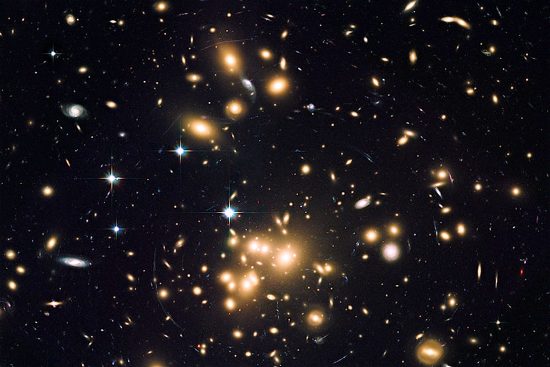
Mar 14, 2019
High temperatures in galaxy clusters are an enigma.
Astronomers use gravity as their primary explanation for most energetic events, like high temperatures in the galaxy cluster shown above. It “must be” because of collisions among its member galaxies in the remote past, or from the merger of two clusters. In visible light, there appears to be an undisturbed galaxy cluster, whereas, in X-ray frequencies, it measures over 70 million Celsius.
In the consensus view, Abell 1689 is thought to be incredibly hot because molecules of gas and dust crashed into each other, creating X-rays. Computer simulations assure astrophysicists that what they see “billions of light-years” away can be modeled on the desktop. It is not surprising that observations appear to match their simulations. The concepts used to build computer algorithms are also in the minds of those working with the instruments. Building a device that is designed to see what has been simulated is how modern science works.
Gases “crashing into each other” to produce X-rays and other energetic emissions reveals a lack of knowledge about electricity in space. The behavior of electricity flowing through plasma is not familiar, so when its effects are observed, they are ascribed to other phenomena. Astronomers believe that plasma is merely ionized gas, behaving according to physical laws that apply to neutral gas. Therefore, their mathematical models are based on neutral gases.
Differences between plasma and neutral gas explain temperature anomalies like the ones seen in galaxy clusters: 10 to 100 times higher than expected. From an Electric Universe point of view, anomalous temperatures are a normal property of plasma interaction between clusters.
Plasma should be thought of as a condition of matter. It is an emergent phenomenon out of complex electrical activity. “Emergent” means: “arising as an effect of complex causes and not analyzable simply as the sum of their effects.” As previously written, properties like filamentation, long-range attraction and short-range repulsion, cell-like differentiation, and characteristic instabilities indicate a system of interaction. Therefore, plasmas in space will defy conventional explanation to the point where the laws of physics and cosmological theories will be twisted trying to explain them. Without adding electricity to the mix, a key component in understanding the Universe, theories will remain incomplete.
In his monograph, Cosmic Plasma, Hannes Alfvén described how theory has lost touch with reality. Rather than theorize about plasma, he studied its properties in the laboratory.
His observation bears repeating:
“The cosmical plasma physics of today…is to some extent the playground of theoreticians who have never seen a plasma in a laboratory. Many of them still believe in formulas which we know from laboratory experiments to be wrong…several of the basic concepts on which theories of cosmical plasmas are founded are not applicable to the condition prevailing in the cosmos. They are ‘generally accepted’ by most theoreticians, they are developed with the most sophisticated mathematical methods; and it is only the plasma itself which does not ‘understand’ how beautiful the theories are and absolutely refuses to obey them…”
Stephen Smith












